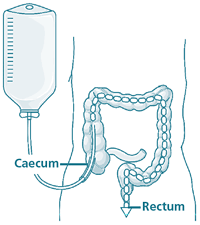What are bowel washouts and why does my child need them?
Bowel washouts are a method of dealing with constipation or with soiling, which is the leakage of faeces (stools) other than during a bowel movement. There are many reasons why a child may soil including:
- Congenital (present at birth) abnormalities affecting the anus and rectum
- Neuropathies (nerve supply problems) as a result of spinal abnormalities like spina bifida.
- Overflow incontinence which is often seen in children with severe constipation.
- Other methods will usually be tried first, and may include bowel training, dietary changes, medications taken by mouth, and medications taken rectally (enemas or suppositories). If these methods fail, doctors may recommend bowel washouts using an antegrade colonic enema (ACE). This can also be called the Malone or MACE method.
What do they involve?
Before you can start doing bowel washouts, your child will need an operation under general anaesthetic. This operation creates a channel (usually using the appendix) into the large bowel at a point called the caecum. The fluid used to wash out the bowel can then be inserted easily. This fluid flushes the faeces out through the rectum in the usual way.
What does the operation involve?
ACE operations are carried out using keyhole surgery (laparoscopy) or open surgery. Depending on the surgical method used, the surgeon may disconnect the appendix from the caecum and then reconnect it. Alternatively, he may leave the appendix in its original position and bring the end up to the wall of the tummy. In both methods, the end of the appendix is opened up to form a channel from the tummy wall to your child’s large bowel. This is called a stoma (artificial opening).
If your child has already had his or her appendix removed or if it is not suitable, the surgeon may need to use a piece of the small bowel to create the passage.
Are there any risks?
All treatments carry an element of risk, but this must be balanced against the quality of life without treatment.
What happens afterwards?
Your child will come back to the ward to recover. For the first day or two, he or she will have a drip giving fluids and medication until the bowel starts to recover. The drip will be removed when your child starts eating and drinking again.
The surgeon will have inserted a catheter (thin, plastic tube) into the stoma to keep it open. This should stay in place for seven to fourteen days after the operation. In some cases, the catheter may need to stay in place for longer. This varies from child to child.
When your child has recovered from the operation, and eating and drinking again, the nurse will teach you how to do bowel washouts using the ACE. When you are confident, you and your child will be able to return home.
Looking after the stoma
You should insert a catheter into the stoma each day to keep it open, even if no washout is planned for that day. We will give you two sizes of catheter, the size you will be using to do the washout and one a size smaller. Alternatively, you can insert the small silicone plug into the stoma.
The stoma can shrink a little after the operation, but this usually settles down when you use the catheter. On rare occasions, the stoma may need stretching while your child is under a general anesthetic.
Starting washouts
Nurses will teach you how to do the bowel washouts when the stoma has settled down, usually between two and three days after the operation. If you and your child have returned home, you will need to come back to the hospital for teaching. You will have a lot to learn about bowel washouts and it may feel daunting at first, but will quickly become easier.
The washout solution varies from child to child, depending on his or her needs. The amount of fluid also varies and is worked out according to your child’s age and size. For the first few weeks, the make-up of the solution may need changing to get the best result.
It may take about six to eight weeks to get into a routine and for the washouts to work effectively. It can help to keep a daily diary of progress. You will also need to keep in contact with your doctor for the first few months until you and your child have settled into a regular washout pattern.





